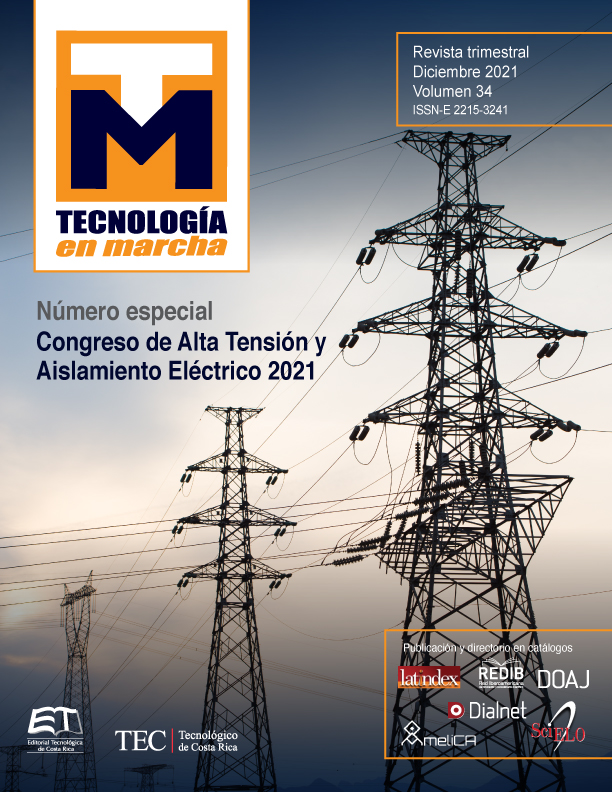Development of artificial intelligence algorithms for detection of defects in surge arresters from thermal images
Main Article Content
Abstract
The main faults in surge arresters are commonly associated with current rises and, therefore, with heating by the Joule effect. Thus, thermovision is a very suitable technique for detecting defects in this electrical power system equipment. However, the use of thermovision to identify possible failures in surge arresters depends on an experienced operator to interpret the obtained results, which many times are subject to interpretation errors. This work aims to apply Artificial Intelligence techniques to classify surge arrester thermal images. Artificial Intelligence algorithms based on Artificial Neural Networks and deep learning techniques were developed for this purpose, considering that many authors have succeeded in using these methods in failure diagnosis in other equipment in the electrical power system. The results obtained showed that the neural networks developed by the backpropagation algorithm presented good efficiency when classifying surge arrester thermal images, and there is no need to segment the surge arrester from the thermal image to carry out the classification.
Article Details

This work is licensed under a Creative Commons Attribution-NonCommercial-NoDerivatives 4.0 International License.
Los autores conservan los derechos de autor y ceden a la revista el derecho de la primera publicación y pueda editarlo, reproducirlo, distribuirlo, exhibirlo y comunicarlo en el país y en el extranjero mediante medios impresos y electrónicos. Asimismo, asumen el compromiso sobre cualquier litigio o reclamación relacionada con derechos de propiedad intelectual, exonerando de responsabilidad a la Editorial Tecnológica de Costa Rica. Además, se establece que los autores pueden realizar otros acuerdos contractuales independientes y adicionales para la distribución no exclusiva de la versión del artículo publicado en esta revista (p. ej., incluirlo en un repositorio institucional o publicarlo en un libro) siempre que indiquen claramente que el trabajo se publicó por primera vez en esta revista.
References
A. D’Ajuz, F. M. Resende, F. M. S. Carvalho, I. G. Nunes, J. Amon Filho, L. E. N. Dias, M. P. Pereira, O. Kastrup Filho, S. A. Morais, “Equipamentos Elétricos: Especificação e Aplicação em Subestações de Alta Tensão”, Universidade Federal Fluminense, Brasil, 1985.
V. Hinrichsen, “Metal-Oxide Surge Arresters Fundamentals”, Siemens AG, 1st edition, 2001.
C. Heinrich & V. Hinrichsen, “Diagnostics and monitoring of metal-oxide surge arresters in high-voltage networks-comparison of existing and newly developed procedures”, In IEEE Transactions on Power Delivery, vol. 16, no. 1, pp. 138-143, Jan. 2001. https://doi.org/10.1109/61.905619.
G. R. S. Lira, “Monitoramento de Para-raios de Óxido de Zinco com Base na Medição da Corrente de Fuga Total”, Tese de Doutorado, Universidade Federal de Campina Grande, Brasil, 2012.
E. T. Wanderley Neto, “Monitoramento e Diagnóstico de Para-raios a ZnO Através de Redes Neurais Artificiais”, Tese de Doutorado, Universidade Federal de Campina Grande, Brasil, 2007.
G. R. S. Lira, E. G. da Costa, D. Fernandes Júnior, V. D. S. Brito, M. J. A. Maia, “Sistema Automático de Diagnóstico de Falhas em Para-raios de ZnO Baseado na Análise de Termografias”, XXI Seminário Nacional de Produção e Transmissão de Energia Elétrica (SNPTEE), Florianópolis, Brasil, Outubro, 23 - 26, 2011.
G. Mazoni, “Sistema para Interface e Diagnóstico de Inspeções Termográficas Automatizadas por Inteligência Artificial para Redes de Distribuição de Energia Elétrica”, Tese de Doutorado, Universidade Estadual de Campinas, Brasil, 2018.
Y. Higuchi & T. Babasaki, “Failure detection of solar panels using thermographic images captured by drone”,
7th International Conference on Renewable Energy Research and Application (ICRERA), 2018, pp. 391396. https://doi.org/10.1109/ICRERA.2018.8566833
H. P. C. Hwang, C. C. Y. Ku & J. C. C. Chan, “Detection of Malfunctioning Photovoltaic Modules Based on Machine Learning Algorithms”, In IEEE Access, vol. 9, pp. 37210-37219, 2021 https://doi.org/10.1109/ ACCESS.2021.3063461
X. Gong, Q. Yao, M. Wang & Y. Lin, “A Deep Learning Approach for Oriented Electrical Equipment Detection in Thermal Images”, In IEEE Access, vol. 6, pp. 41590-41597, 2018, https://doi.org/10.1109/ ACCESS.2018.2859048
J. Chen, Y. Li & Q. Ling, “Hot-Spot Detection for Thermographic Images of Solar Panels”, 2020 Chinese Control And Decision Conference (CCDC), pp. 4651-4655, https://doi.org/10.1109/CCDC49329.2020.9164255
Y. Olivatti, C. Penteado, P. T. Aquino & R. F. Maia, “Analysis of artificial intelligence techniques applied to thermographic inspection for automatic detection of electrical problems”, 2018 IEEE International Smart Cities Conference (ISC2), pp. 1-5, https://doi.org/10.1109/ISC2.2018.8656724
H. Zou, & H. Fuzhen, “An Intelligent Fault Diagnosis Method for Electrical Equipment Using Infrared Images”, Proceedings of the 34th Chinese
Control Conference , pp. 6372-6376, 2015. https://doi.org/10.1109/ChiCC.2015.7260642
S. A. Merryman & R. M. Nelms, “Diagnostic technique for power systems utilizing infrared thermal imaging”, In IEEE Transactions on Industrial Electronics, vol. 42, no. 6, pp. 615-628, Dec. 1995, https://doi. org/10.1109/41.475502
G. M. Santos, “Termografia e Inteligência Artificial na Detecção de Falhas em Transformadores”, Tese de doutorado, Universidade Federal do Pernambuco, Brasil, 2017.
R. H. F. Alves, G. A. Deus Júnior, F. H. T. Vieira, M. S. Castro, S. G. Araújo, R. P. Lemos, “Detecção de Anomalias em Painéis Fotovoltaicos Utilizando Redes ABNET, PSOM e MLP”, VI Congresso Brasileiro de Energia Solar (CBENS), Belo Horizonte, Brasil, Abril, 04 – 07, 2016.
G. L. Ribeiro, “Aprimoramento da Classificação de Isoladores Poliméricos por Medições Termográficas e Radiação UV”, Tese de doutorado, Universidade Federal de Campina Grande, Brasil, 2017.
S. Haykin, “Redes Neurais - Princípios e Práticas”, Bookman, 2001.
A. P. Braga, T. B. Ludermir, A. C. P. L. F. Carvalho, “Redes Neurais Artificiais: Teoria e Aplicações”, Rio de Janeiro: LTC, 2000.
N. Yali, “A Multi-stage Convolution Machine with Scaling and Dilation for Human Pose Estimation”, Thesis (Master degree Department of Electronic Engineering), Graduate School of Chonbuk National University, Republic of Korea, 2018.
I. Goodfellow, Y. Bengio, & A. Courville, “Deep Learning”, Cambridge, MA: MIT Press, 2016
L. S. Abdalla & C. F. S. Volotão, “Estudo da Configuração de Diferentes Arquiteturas de Redes Neurais Artificiais MLP para Classificação de Imagens Ópticas”, XVI Simpósio Brasileiro de Sensoriamento Remoto (SBSR), Foz do Iguaçu, Brasil. INPE, 2013.

